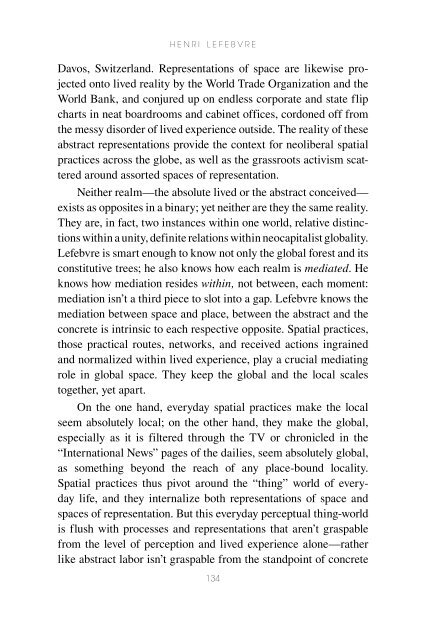Henri Lefebvre: A Critical Introduction - autonomous learning
Henri Lefebvre: A Critical Introduction - autonomous learning
Henri Lefebvre: A Critical Introduction - autonomous learning
You also want an ePaper? Increase the reach of your titles
YUMPU automatically turns print PDFs into web optimized ePapers that Google loves.
H e n r i L e F e b v r e<br />
Davos, Switzerland. Representations of space are likewise projected<br />
onto lived reality by the World Trade Organization and the<br />
World Bank, and conjured up on endless corporate and state flip<br />
charts in neat boardrooms and cabinet offices, cordoned off from<br />
the messy disorder of lived experience outside. The reality of these<br />
abstract representations provide the context for neoliberal spatial<br />
practices across the globe, as well as the grassroots activism scattered<br />
around assorted spaces of representation.<br />
Neither realm—the absolute lived or the abstract conceived—<br />
exists as opposites in a binary; yet neither are they the same reality.<br />
They are, in fact, two instances within one world, relative distinctions<br />
within a unity, definite relations within neocapitalist globality.<br />
<strong>Lefebvre</strong> is smart enough to know not only the global forest and its<br />
constitutive trees; he also knows how each realm is mediated. He<br />
knows how mediation resides within, not between, each moment:<br />
mediation isn’t a third piece to slot into a gap. <strong>Lefebvre</strong> knows the<br />
mediation between space and place, between the abstract and the<br />
concrete is intrinsic to each respective opposite. Spatial practices,<br />
those practical routes, networks, and received actions ingrained<br />
and normalized within lived experience, play a crucial mediating<br />
role in global space. They keep the global and the local scales<br />
together, yet apart.<br />
On the one hand, everyday spatial practices make the local<br />
seem absolutely local; on the other hand, they make the global,<br />
especially as it is filtered through the TV or chronicled in the<br />
“International News” pages of the dailies, seem absolutely global,<br />
as something beyond the reach of any place-bound locality.<br />
Spatial practices thus pivot around the “thing” world of everyday<br />
life, and they internalize both representations of space and<br />
spaces of representation. But this everyday perceptual thing-world<br />
is flush with processes and representations that aren’t graspable<br />
from the level of perception and lived experience alone—rather<br />
like abstract labor isn’t graspable from the standpoint of concrete<br />
134
















